Spica, Alpha Virginis (α Vir), is a blue-white spectroscopic binary star located at a distance of 250 light years from Earth in the constellation Virgo. With an apparent magnitude of 0.97, it is the brightest star in Virgo and the 16th brightest star in the sky. Spica is part of the Spring Triangle and the Diamond of Virgo, two prominent asterisms that dominate the evening sky during the northern hemisphere spring.
Star system
The Alpha Virginis system is one of the closest massive binary stars to Earth. The spectroscopic binary star consists of two components in a close orbit. The stars have an orbital period of 4.0145 days. They are separated by only 0.12 astronomical units (12% of the average distance from the Sun to Earth), too close together to be resolved in a telescope.
Spica can only be identified as a double star through its spectral lines. It is a double-lined spectroscopic binary (SB2), which means that the spectral lines of both components are visible in the system’s spectrum, and the lines are sometimes double and sometimes single.
Spica is classified as a rotating ellipsoidal variable, a spectroscopic binary star whose two components are so close together that their shape is distorted by their mutual gravitational interaction. Both components are ellipsoidal in shape.
The two stars do not eclipse each other during their orbit. Instead, they show changes in brightness because of the changes in what the observer sees of the stars as they rotate. The stars’ brightness varies because the stars are egg-shaped, and their apparent diameters change during their orbit. The brightness variations are not caused by any physical changes in the stars themselves.
Rotating ellipsoidal variable stars typically show variations in brightness of up to 0.1 magnitudes and their periods correspond to their orbital motion. Spica is the brightest star of this type in the sky. Its brightness varies by only 0.03 magnitudes and the variations cannot be noticed visually. Other bright rotating ellipsoidal variables include Mothallah (Alpha Trianguli) in the constellation Triangulum and Pi5 Orionis in Orion.
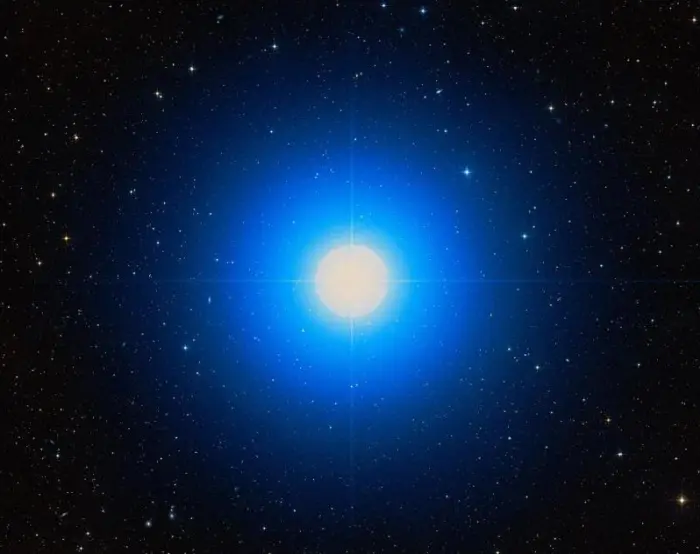
Spica (Alpha Virginis), image credit: ESO/Digitized Sky Survey 2 (CC BY 4.0)
Alpha Virginis A (Spica), the primary component in the Alpha Virginis system, has the stellar classification B1III-IV, indicating a blue giant or subgiant star. The evolved star has an estimated mass 11.43 times that of the Sun and a radius 7.47 times solar. With an effective temperature of about 25,300 kelvin, it is 20,512 times more luminous than the Sun. A lot of its energy output is in the invisible ultraviolet.
The star is a fast spinner, with a projected rotational velocity of 165.3 km/s. It has an estimated age of 12.5 million years.
Spica is one of the nearest stars to the solar system that is massive enough to be a type II supernova candidate. When it comes to the end of its life cycle, it will suffer a core collapse and go out as a brilliant supernova.
Spica is classified as a Beta Cephei variable. Beta Cephei stars are evolved, hot, blue stars that show small, rapid fluctuations in brightness as a result of pulsations of their outer layers. Spica varies in brightness from magnitude 0.97 to 1.04 with a period of 0.1738 days. Other well-known stars in this class include Hadar (Beta Centauri), Mimosa (Beta Crucis), Imai (Delta Crucis), Mirzam (Beta Canis Majoris), Algenib (Gamma Pegasi), and Shaula (Lambda Scorpii).
The close companion, Alpha Virginis B, is cooler, smaller and less massive. It is a main sequence star of the spectral type B2V. It has a surface temperature of 20,900 K, a radius 3.74 times that of the Sun and a mass of 7.21 solar masses.
Alpha Virginis B has a luminosity 2,254 times that of the Sun and spins with a projected rotational velocity of 58.8 km/s. The strength of the star’s spectral lines varies during the orbital motion, becoming weaker as the star moves away from the observer. This may be caused by the strong stellar wind from Spica A scattering its light. It is known as the Struve-Sahade effect.
Both stars rotate more rapidly than their orbital period. The lack of synchronization, coupled with a highly elliptical orbit, may indicate that the star system is still young. The stars’ gravitational interaction over time may reduce the eccentricity of their orbit and lead to more synchronous rotation.
A study published in 2016 revealed that Spica is a polarimetric variable. Most of the polarimetric signal comes from the reflection of the primary star’s light off the companion and vice versa.
The two stars were the first to have their geometric albedo (reflectivity) measured. A study published in 2019 yielded geometric albedos of 3.61 percent and 1.36 percent for Spica A and Spica B. Even though the stars reflect very little of the incident light, the reflected light is highly polarized.
Facts
With an apparent magnitude of 0.97, Spica is the 16th brightest star in the night sky. It is only slightly fainter than Altair in the constellation Aquila, Acrux in Crux, Aldebaran in Taurus, and Antares in Scorpius. It just outshines Pollux in Gemini and Fomalhaut in Piscis Austrinus.
Spica is one of the 58 bright stars selected for use in navigation. Navigational stars play a special role in the field of celestial navigation because they are some of the brightest and most identifiable stars in the sky. Spica is the only navigational star in the constellation Virgo. It is easy to identify because it is part of three prominent star patterns.
Spica is part of two large seasonal asterisms, the Spring Triangle and the Diamond of Virgo (the Great Diamond). It forms the Spring Triangle with Arcturus in the constellation Boötes and Regulus in Leo. Spica and Arcturus also form the Diamond of Virgo with Denebola in Leo and Cor Caroli in Canes Venatici.
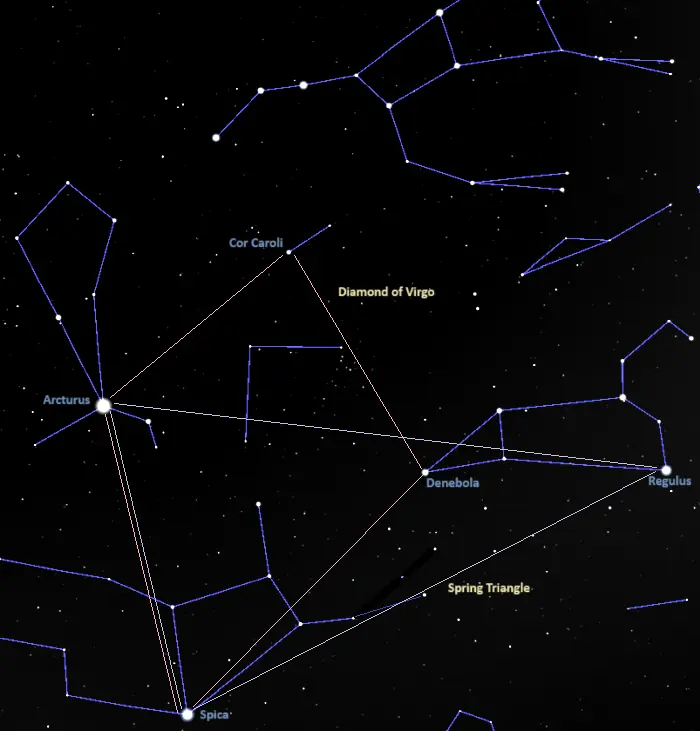
The Spring Triangle and the Great Diamond (Diamond of Virgo), image credit: Stellarium
Spica marks the base of the Y of Virgo, a constellation-based asterism formed by some of Virgo’s brightest stars, including Porrima (Gamma Virginis), Minelauva (Delta Virginis), Vindemiatrix (Epsilon Virginis), Zaniah (Eta Virginis), and Zavijava (Beta Virginis). Without Spica, the pattern is known as the Bowl of Virgo. It can be used to find the Virgo Cluster of galaxies, whose centre lies halfway between Vindemiatrix in Virgo and Denebola in Leo.
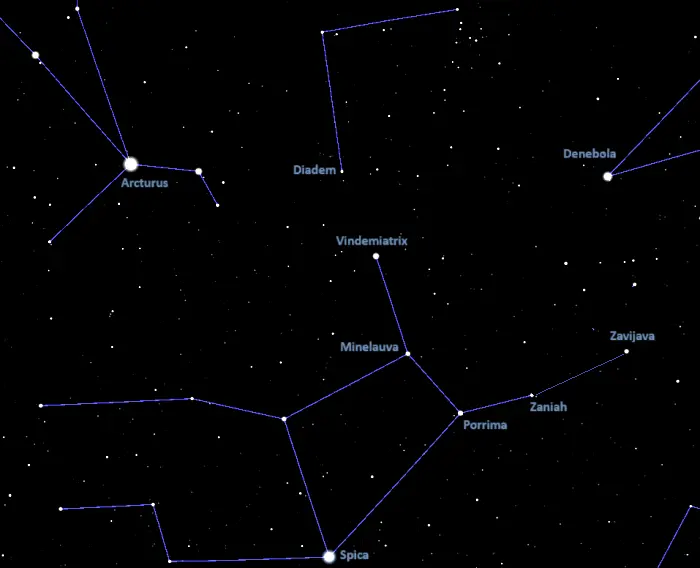
The Y of Virgo and Bowl of Virgo, image: Stellarium
Spica lies only 2.06 degrees from the ecliptic, which means that it can be occulted by the Moon and, more rarely, by planets. The last occultation by a planet occurred on November 10, 1783, when the planet Venus passed in front of the star. The next planetary occultation (also by Venus) will take place on September 2, 2197.
The Sun and the planets pass near the star more often. The Sun comes within a little over 2 degrees north of Spica in mid-October every year, two weeks before the star’s heliacal rising (rising above the horizon at dawn after a period of invisibility). Venus passes near the star in late October or early November every 8 years.
Spica is believed to have played a crucial role in the discovery of the Earth’s axial precession (precession of the equinoxes). The discovery is usually attributed to the Greek astronomer Hipparchus (190-120 BCE), who measured the longitude of Spica and other bright stars.
After comparing his measurements with those given by Timocharis and Aristillus (3rd century BCE), Hipparchus found that Spica had moved two degrees relative to the autumnal equinox (the instant when the plane of the Earth’s equator aligns with the path of the Sun and the Sun can be seen directly above the equator). He concluded that the equinoxes were moving through the constellations of the zodiac and that the precession rate was at least a degree every century.
The autumnal equinox lies halfway between Spica and the bright Regulus in the constellation Leo.
Spica is one of the 27 stars represented on the flag of Brazil. Each star symbolizes a Brazilian Federative Unit and Spica represents the state of Pará. It is the only star above the white band, symbolizing a part of the territory north of the equator.
Spica was of some importance in ancient Egypt and Greece. In Egypt, it was known as the Lute-Bearer and Repa, “the lord.” A temple to Menat (one of the names of the goddess Hathor), built around 3200 BCE, and the temple of the Sun at Tell el-Amarna, built around 2000 BCE, were oriented to Spica’s setting. Due to axial precession, the star’s location relative to the temple has changed over time.
Several temples in Greece were also found that were constructed relative to Spica’s motion across the sky. These include two temples at Rhamnus from 1092 and 747 BCE, temples to Hera at Olympia, Argos and Girgenti, and the temple of Nike Apteros at Athens (1130 BCE).
In medieval astrology, Spica was one of the 15 Behenian fixed stars, believed to be a source of special astrological power. The star was linked with the planets Mercury and Venus and associated with emerald and sage, which were used in rituals to bring out the star’s influence.
Name
The name Spica (pronunciation: /ˈspaɪkə/) comes from the Latin phrase spīca virginis, meaning “the virgin’s ear of grain.” The name was officially approved by the International Astronomical Union’s (IAU) Working Group on Star Names (WGSN) on June 30, 2016. It formally applies only to the component Alpha Virginis Aa.
The star has been known by many other names throughout history. The Latin Spica Virginis was translated into English as Virgin’s Spike. The German uranographer Johann Bayer used the name Arista. Arabic derivations included Alarph, “the grape gatherer”, Sumbalet, “ear of grain,” and Azimech, derived from Al Simak al A’zal, meaning “the unarmed” or “the defenceless,” unguarded by any other star.
The 13th century Persian astronomer Zakariya al-Qazwini called the star Sak al Asad, meaning “the shin-bone of the Lion.” Spica was a part of an enormous asterism, the Lion, which included several other stars in Virgo that outlined one of the lion’s legs. Spica and Arcturus marked the Lion’s shin-bones, the stars of Corvus formed the hindquarters, Pollux and Castor in Gemini one of the front paws, Canis Minor stars the other paw, and Regulus in Leo the forehead. The asterism occupied about a third of the sky.
The Chinese name for the star is 角宿一 (Jiǎo Xiù yī), meaning the First Star of Horn. In traditional Chinese astronomy, Spica formed an asterism known as Horn with Heze, Zeta Virginis. The asterism was part of the larger Horn mansion, which represented the horns of the Azure Dragon.
In Hindu astronomy, Spica was known as Chitra (“the bright one”) and associated with the 12th lunar mansion (nakshatra) of the same name.
In Babylonian astronomy, the star represented the wife of Bel and was known as Sa-Sha-Shiru, meaning “the virgin’s girdle.”
Location
Spica is easy to find because it lies on the imaginary line arching away from the three stars of the Big Dipper’s handle, Alioth, Mizar and Alkaid. Following the arc of the handle first leads to the bright Arcturus in the constellation Boötes and then to Spica.

The location of Spica (Alpha Virginis), image: Stellarium
The brightest stars in the neighbouring constellation Corvus (the Crow) form an asterism known as Spica’s Spanker or the Sail. The northern side of the asterism points in Spica’s direction. A line extended from Gienah through Algorab leads to Virgo’s brightest star.
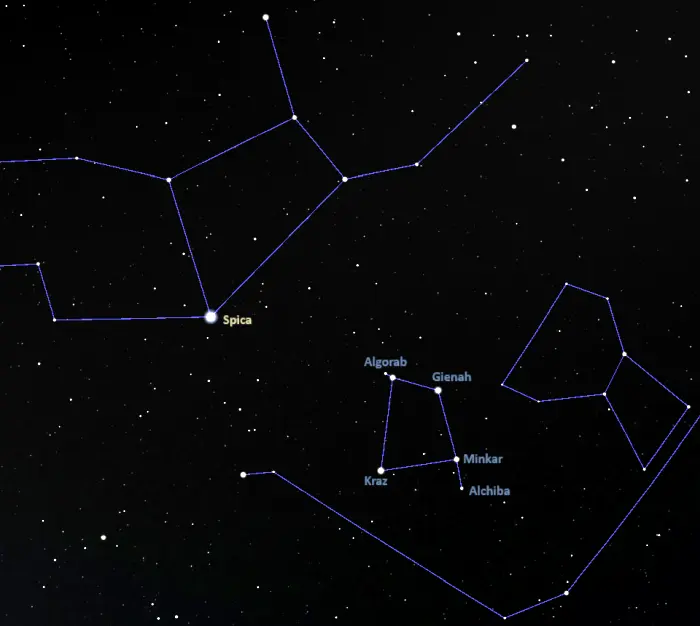
Spica and Spica’s Spanker (the Sail), formed by Gienah, Algorab, Kraz and Minkar in the constellation Corvus, image: Stellarium
Constellation
Spica is located in the constellation Virgo. It marks the ear of wheat held in the celestial Virgin’s left hand. Like all zodiac constellations, Virgo lies on the ecliptic, the Sun’s apparent path across the sky. It is one of the Greek constellations, first listed by Ptolemy of Alexandria in the 2nd century CE. It is the second largest constellation in the sky, after Hydra, occupying an area of 1,294 square degrees.
In Greek mythology, Virgo is associated with Demeter, the goddess of the harvest, her daughter Persephone, the goddess of the spring and the queen of the underworld, and with Astraea, the goddess of justice and purity, depicted as holding the scales of justice (represented by the constellation Libra).
Virgo is one of the 15 constellations that lie on the celestial equator. Like all equatorial constellations, it is visible from virtually anywhere for at least part of the year.
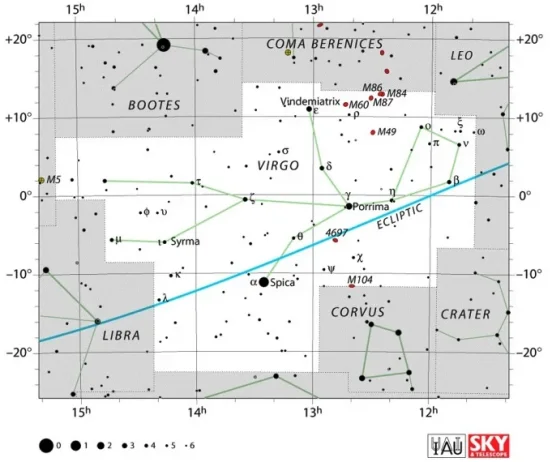
Virgo constellation map by IAU and Sky&Telescope magazine (Roger Sinnott & Rick Fienberg) (CC BY 3.0)
In addition to Spica, notable stars in Virgo include the binary star systems Gamma Virginis (Porrima), Iota Virginis (Syrma) and Lambda Virginis (Khambalia), the yellow giants Vindemiatrix (Epsilon Virginis) and Omicron Virginis, the fast-spinning A-type star Heze (Zeta Virginis A), the red giants Minelauva (Delta Virginis) and Nu Virginis, the orange giant star Kang (Kappa Virginis), the yellow-white main sequence stars Zavijava (Beta Virginis) and Mu Virginis, and the triple star system Eta Virginis (Zaniah).
Virgo also contains the Sun-like yellow dwarfs 61 Virginis and HD 125612, with three orbiting exoplanets each, and the red dwarf Ross 128, which hosts the second nearest Earth-sized extrasolar planet known, after Proxima b in the Proxima Centauri system.
Virgo contains as many as 11 Messier objects (bright deep sky objects catalogued by the 18th century French astronomer and comet hunter Charles Messier). Most of these are galaxies located in the Virgo Cluster, the nearest large galaxy cluster to the Local Group. The brightest members of the Virgo Cluster are visible in small telescopes. The centre of the cluster is found within the Spring Triangle, about halfway between Denebola in Leo and Vindemiatrix in Virgo.
The Virgo Cluster members located in the constellation Virgo include Messier 87 (Virgo A, the Smoking Gun), a supergiant elliptical galaxy whose supermassive black hole was the first to be directly imaged, the bright elliptical galaxy Messier 49, the barred spiral galaxies Messier 58, Messier 61 and NGC 4639, and the interacting pairs NGC 4435 and NGC 4438, also known as the Eyes Galaxies, and NGC 4567 and NGC 4568, nicknamed the Butterfly Galaxies.
Virgo is also home to the famous Sombrero Galaxy (Messier 104), located 11.5 degrees west of Spica, and to the supergiant elliptical galaxy IC 1101, one of the largest galaxies ever discovered.
The best time of the year to observe the stars and deep sky objects of Virgo is during the month of May, when the constellation appears higher above the horizon in the early evening. The entire constellation is visible from locations between the latitudes +80° and -80°.
The 10 brightest stars in Virgo are Spica (Alpha Vir, mag. 0.97), Porrima (Gamma Vir, mag. 2.74), Vindemiatrix (Epsilon Vir, mag. 2.826), Heze (Zeta Vir, mag. 3.376), Minelauva (Delta Vir, mag. 3.39), Zavijava (Beta Vir, mag. 3.604), 109 Virginis (mag. 3.72), Mu Virginis (mag. 3.88), Zaniah (Eta Vir, mag. 3.89), and Nu Virginis (mag. 4.04).
Spica – Alpha Virginis
| Spectral class | B1III-IV + B2V |
| Variable type | Beta Cephei and rotating ellipsoidal variable |
| U-B colour index | -0.94 |
| B-V colour index | -0.23 |
| Apparent magnitude | 0.97 (0.97 – 1.04) |
| Absolute magnitude | -3.55 (−3.5/−1.5) |
| Distance | 250 ± 10 light years (77 ± 4 parsecs) |
| Parallax | 13.06 ± 0.70 mas |
| Radial velocity | -3.310 ± 0.780 |
| Proper motion | RA: −42.35 ± 0.62 mas/yr |
| Dec.: −30.67 ± 0.37 mas/yr | |
| Constellation | Virgo |
| Right ascension | 13h 25m 11.57937s |
| Declination | −11° 09′ 40.7501″ |
| Designations | Spica, Alpha Virginis, α Virginis, α Vir, 67 Virginis, HD 116658, HR 5056, HIP 65474, SAO 157923, FK5 498, PPM 227262, PLX 3063, GCTP 18144, GC 18144, GCRV 7963, BD-10°3672, SKY# 24751, CSI-10 3672 1, SBC7 487, SBC9 766, RAFGL 1622, HGAM 623, ALS 14813, IRC -10286, RBS 1263, TD1 16831, GEN# +1.00116658, GSC 05547-01518, EUVE J1325-11.1, JP11 2392, SACS 290, WEB 11556, TIC 178999156, UBV 12103, UBV M 19362, RE J1325-110, RE J132512-110856, 2RE J1325-111, 2RE J132508-111117, PMC 90-93 354, 2E 3039, 2E 1322.5-1053, 1ES 1322-10.8, N30 3066, ROT 1963, MCW 553, 1RXS J132511.6-110932, RX J1325.2-1109, IRAS 13225-1054, 2MASS J13251158-1109404, AKARI-IRC-V1 J1325115-110940, uvby98 100116658, TYC 5547-1518-1, CCDM 13252-1109, IDS 13200-1038, WDS J13252-1110 |
Alpha Virginis A
| Spectral class | B1III-IV |
| Variable type | Beta Cephei |
| Absolute magnitude | -3.5 |
| Mass | 11.43 ± 1.15 M☉ |
| Luminosity | 20,512 L☉ (16,482 – 25,527 L☉) |
| Radius | 7.47 ± 0.54 R☉ |
| Temperature | 25,300 ± 500 K |
| Age | 12.5 million years |
| Rotational velocity | 165.3 ± 4.5 km/s |
| Surface gravity | 3.71 ± 0.10 cgs |
Alpha Virginis B
| Spectral class | B2V |
| Absolute magnitude | -1.5 |
| Mass | 7.21 ± 0.75 M☉ |
| Luminosity | 2,254 L☉ (1,486 – 3,420 L☉) |
| Radius | 3.74 ± 0.53 R☉ |
| Temperature | 20,900 ± 800 K |
| Rotational velocity | 58.8 ± 1.5 km/s |
| Surface gravity | 4.15 ± 0.15 cgs |